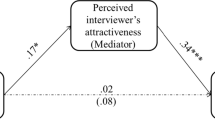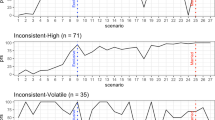Abstract
Long-term romantic commitments may offer many benefits. It is thus unsurprising that people employ strategies that help protect their relationships against the allure of alternative partners. The present research focused on the circumstances under which these strategies are less effective. Specifically, four studies examined the effect of internal relationship threat on expressions of desire for alternative mates. In Study 1, participants reported perceptions of relationship threat, their desire for their partner, and expressions of attraction to alternative mates. In Studies 2–4, participants underwent a threat manipulation and then encountered attractive strangers. Their reactions during these encounters (expressed interest, provision of help, and overt flirtation in Studies 2, 3, and 4, respectively) were recorded. Results showed that experiencing threat led to increased expressions of desire for alternatives. As indicated in Studies 1 and 2, decreased desire for current partners partially explained this effect, suggesting that desire functions as a gauge of romantic compatibility, ensuring that only valued relationships are maintained.


Similar content being viewed by others
References
Allen, E. S., Atkins, D. C., Baucom, D. H., Snyder, D. K., Gordon, K. C., & Glass, S. P. (2005). Intrapersonal, interpersonal, and contextual factors in engaging in and responding to extramarital involvement. Clinical Psychology: Science and Practice, 12, 101–130.
Amato, P. R., & Previti, D. (2003). People’s reasons for divorcing: Gender, social class, the life course, and adjustment. Journal of Family Issues, 24, 602–626.
Andersen, P. A. (1985). Nonverbal immediacy in interpersonal communication. In A. W. Siegman & S. Feldstein (Eds.), Multichannel integrations of nonverbal behavior (pp. 1–36). Hillsdale, NJ: Erlbaum.
Atkins, D. C., Baucom, D. H., & Jacobson, N. S. (2001). Understanding infidelity: Correlates in a national random sample. Journal of Family Psychology, 15(4), 735–749.
Atwood, J. D., & Seifer, M. (1997). Extramarital affairs and constructed meanings: A social constructionist therapeutic approach. American Journal of Family Therapy, 25, 55–74.
Bell, R. A., & Daly, J. A. (1984). The affinity-seeking function of communication. Communication Monographs, 51, 91–115.
Berscheid, E., & Regan, P. C. (2005). The psychology of interpersonal relationships. Mahwah, NJ: Prentice-Hall.
Birnbaum, G. E. (2018). The fragile spell of desire: A functional perspective on changes in sexual desire across relationship development. Personality and Social Psychology Review, 22(2), 101–127.
Birnbaum, G. E., & Finkel, E. J. (2015). The magnetism that holds us together: Sexuality and relationship maintenance across relationship development. Current Opinion in Psychology, 1, 29–33.
Birnbaum, G. E., Mikulincer, M., Szepsenwol, O., Shaver, P. R., & Mizrahi, M. (2014). When sex goes wrong: A behavioral systems perspective on individual differences in sexual attitudes, motives, feelings, and behaviors. Journal of Personality and Social Psychology, 106, 822–842.
Birnbaum, G. E., Reis, H. T., Mizrahi, M., Kanat-Maymon, Y., Sass, O., & Granovski-Milner, C. (2016). Intimately connected: The importance of partner responsiveness for experiencing sexual desire. Journal of Personality and Social Psychology, 111, 530–546.
Birnbaum, G. E., Simpson, J. A., Weisberg, Y. J., Barnea, E., & Assulin-Simhon, Z. (2012). Is it my overactive imagination? The effects of contextually activated attachment insecurity on sexual fantasies. Journal of Social and Personal Relationships, 29, 1131–1152.
Birnbaum, G. E., Svitelman, N., Bar-Shalom, A., & Porat, O. (2008). The thin line between reality and imagination: Attachment orientations and the effects of relationship threats on sexual fantasies. Personality and Social Psychology Bulletin, 34, 1185–1199.
Birnbaum, G. E., Weisberg, Y. J., & Simpson, J. A. (2011). Desire under attack: Attachment orientations and the effects of relationship threat on sexual motivations. Journal of Social and Personal Relationships, 28, 448–468.
Blow, A. J., & Hartnett, K. (2005). Infidelity in committed relationships II: A substantive review. Journal of Marital and Family Therapy, 31, 217–233.
Bono, G., McCullough, M. E., & Root, L. M. (2008). Forgiveness, feeling connected to others, and well-being: Two longitudinal studies. Personality and Social Psychology Bulletin, 34, 182–195.
Braver, S., Thoemmes, F., & Rosenthal, B. (2014). Cumulative meta-analysis and replicability. Perspectives on Psychological Science, 9, 333–342.
Brown, E. M. (1991). Patterns of infidelity and their treatment. New York: Brunner/Mazel.
Buss, D. M., Goetz, C., Duntley, J. D., Asao, K., & Conroy-Beam, D. (2017). The mate switching hypothesis. Personality and Individual Differences, 104, 143–149.
Cavallo, J. V., Fitzsimons, G. M., & Holmes, J. G. (2010). When self-protection overreaches: Relationship-specific threat activates domain-general avoidance motivation. Journal of Experimental Social Psychology, 46, 1–8.
Cohen, J. (1988). Statistical power analysis for the behavioral sciences (2nd ed.). New York, NY: Academic Press.
DeWall, C., Lambert, N., Slotter, E., Pond, R., Deckman, T., Finkel, E., … Fincham, F. (2011). So far away from one’s partner, yet so close to romantic alternatives: Avoidant attachment, interest in alternatives, and infidelity. Journal of Personality and Social Psychology, 101, 1302–1316.
Dush, C. M. K., & Amato, P. R. (2005). Consequences of relationship status and quality for subjective well-being. Journal of Social and Personal Relationships, 22(5), 607–627.
Eibl-Eibesfeldt, I. (1989). Human ethology. New York: de Gruyter.
Faul, F., Erdfelder, E., Buchner, A., & Lang, A. G. (2009). Statistical power analyses using G*Power 3.1: Tests for correlation and regression analyses. Behavior Research Methods, 41, 1149–1160.
Finkel, E. J., Simpson, J. A., & Eastwick, P. W. (2017). The psychology of close relationships: Fourteen core principles. Annual Review of Psychology, 68, 4.1–4.29.
Fritz, M. S., & MacKinnon, D. P. (2007). Required sample size to detect the mediated effect. Psychological Science, 18, 233–239.
Gonzalez, R. (2008). Data analysis for experimental design. New York, NY: Guilford Press.
Hayes, A. F. (2013). Introduction to mediation, moderation, and conditional process analysis. New York, NY: Guilford Press.
Impett, E. A., Gordon, A. M., Kogan, A., Oveis, C., Gable, S. L., & Keltner, D. (2010). Moving toward more perfect unions: Daily and long-term consequences of approach and avoidance goals in romantic relationships. Journal of Personality and Social Psychology, 99, 948–963.
Jostmann, N. B., Karremans, J., & Finkenauer, C. (2011). When love is not blind: Rumination impairs implicit affect regulation in response to romantic relationship threat. Cognition and Emotion, 25, 506–518.
Karremans, J. C., & Van Lange, P. A. M. (2004). Back to caring after being hurt: The role of forgiveness. European Journal of Social Psychology, 34, 207–227.
Karremans, J. C., & Verwijmeren, T. (2008). Mimicking attractive opposite-sex others: The role of romantic relationship status. Personality and Social Psychology Bulletin, 34, 939–950.
Kenny, D. (2013). PowMedR. R program to compute power of joint test for continuous exposure, mediator, and outcome. Retrieved December 16, 2015 from http://davidakenny.net/progs/PowMedR.txt.
Leck, K., & Simpson, J. (1999). Feigning romantic interest: The role of self-monitoring. Journal of Research in Personality, 33(1), 69–91.
Lipsey, M. W., & Wilson, D. B. (2001). Practical meta-analysis. Thousand Oaks, CA: Sage.
Lydon, J. E., Fitzsimons, G. M., & Naidoo, L. (2003). Devaluation versus enhancement of attractive alternatives: A critical test using the calibration paradigm. Personality and Social Psychology Bulletin, 29, 349–359.
Lydon, J., & Karremans, J. C. (2015). Relationship regulation in the face of eye candy: A motivated cognition framework for understanding responses to attractive alternatives. Current Opinion in Psychology, 1, 76–80.
Maner, J. K., Rouby, D. A., & Gonzaga, G. C. (2008). Automatic inattention to attractive alternatives: The evolved psychology of relationship maintenance. Evolution and Human Behavior, 29, 343–349.
Marigold, D. C., Holmes, J. G., & Ross, M. (2007). More than words: Reframing compliments from romantic partners fosters security in low self-esteem individuals. Journal of Personality and Social Psychology, 92, 232–248.
Mark, K. P., Janssen, E., & Milhausen, R. R. (2011). Infidelity in heterosexual couples: Demographic, interpersonal, and personality-related predictors of extradyadic sex. Archives of Sexual Behavior, 40(5), 971–982.
Mattingly, B. A., Clark, E. M., Weidler, D. J., Bullock, M., Hackathorn, J., & Blankmeyer, K. (2011). Sociosexual orientation, commitment, and infidelity: A mediation analysis. Journal of Social Psychology, 151, 222–226.
Mizrahi, M., Hirschberger, G., Mikulincer, M., Szepsenwol, O., & Birnbaum, G. E. (2016). Reassuring sex: Can sexual desire and intimacy reduce relationship-specific attachment insecurities? European Journal of Social Psychology, 46(4), 467–480.
Murray, S. L., Derrick, J. L., Leder, S., & Holmes, J. G. (2008). Balancing connectedness and self-protection goals in close relationships: A levels-of-processing perspective on risk regulation. Journal of Personality and Social Psychology, 94(3), 429–459.
Reis, H. T., Collins, W. A., & Berscheid, E. (2000). The relationship context of human behavior and development. Psychological Bulletin, 126, 844–872.
Reis, H. T., & Gable, S. L. (2000). Event-sampling and other methods for studying everyday experience. In H. T. Reis & C. M. Judd (Eds.), Handbook of research methods in social and personality psychology (pp. 190–222). New York: Cambridge University Press.
Ritter, S. M., Karremans, J. C., & van Schie, H. T. (2010). The role of self-regulation in derogating attractive alternatives. Journal of Experimental Social Psychology, 46(4), 631–637.
Scott, S. B., Parsons, A., Post, K. M., Stanley, S. M., Markman, H. J., & Rhoades, G. K. (2016). Changes in the sexual relationship and relationship adjustment precede extradyadic sexual involvement. Archives of Sexual Behavior, 46(2), 395–406.
Scott, S. B., Rhoades, G. K., Stanley, S. M., Allen, E. S., & Markman, H. J. (2013). Reasons for divorce and recollections of premarital intervention: Implications for improving relationship education. Couple & Family Psychology, 2(2), 131–145.
Simpson, J. A., Gangestad, S. W., & Lerma, M. (1990). Perception of physical attractiveness: Mechanisms involved in the maintenance of romantic relationships. Journal of Personality and Social Psychology, 59, 1192–1201.
van Straaten, I., Engels, R. C. M. E., Finkenauer, C., & Holland, R. W. (2009). Meeting your match: How attractiveness similarity affects approach behavior in mixed-sex dyads. Personality and Social Psychology Bulletin, 35, 685–697.
van Straaten, I., Holland, R. W., Finkenauer, C., Hollenstein, T., & Engels, R. C. M. E. (2010). Gazing behavior during mixed-sex interactions: Sex and attractiveness effects. Archives of Sexual Behavior, 39, 1055–1062.
Wiederman, M. W., & Hurd, C. (1999). Extradyadic involvement during dating. Journal of Social and Personal Relationships, 16(2), 265–274.
Acknowledgements
We would like to thank Bat Primo, May Barbi, Taqwa Jaljolie, and Maya Davidovich for their assistance in the collection of the data and Kobi Zholtack, Romi Orr, Danelle Izakov, Gil Tsessler, Shiran Arinus, Oz Klein, and Ron Lerner for their assistance in conducting the research. This research was supported by the Israel Science Foundation (Grants 86/10 and 1210/16 awarded to Gurit E. Birnbaum) and by the Binational Science Foundation (Grants #2011381 and #2016405 awarded to Gurit E. Birnbaum and Harry T. Reis).
Author information
Authors and Affiliations
Corresponding author
Ethics declarations
Conflict of interest
The authors declare that they have no conflicts of interest with respect to their authorship or the publication of this article.
Ethical Approval
All study procedures were approved by the Ethics Committee of the Faculty of Psychology, Interdisciplinary Center Herzliya, prior to data collection.
Informed Consent
Informed consent was obtained from all individual participants included in this study.
Rights and permissions
About this article
Cite this article
Birnbaum, G.E., Mizrahi, M., Kovler, L. et al. Our Fragile Relationships: Relationship Threat and Its Effect on the Allure of Alternative Mates. Arch Sex Behav 48, 703–713 (2019). https://doi.org/10.1007/s10508-018-1321-5
Received:
Revised:
Accepted:
Published:
Issue Date:
DOI: https://doi.org/10.1007/s10508-018-1321-5




